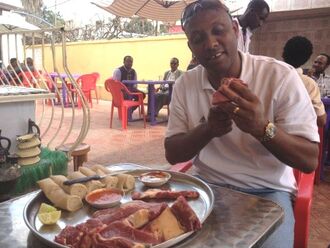When EPRDF/TPLF reached Addis in May 1991
EPLF was still fighting in Asmara
In September 1987, the Amhara anti-government opposition groups known as the Ethiopian People's Democratic Movement (EPDM) was formed. Together with TPLF, they established coalition known as the Ethiopian People's Revolutionary Democratic Front (EPDRF) in 1989, with Meles Zenawi serving a chairman of both the TPLF and EPDM. Mengistu banned the Ethiopian media from using the term glasnost and perestroika, defying Mikhail Gorbachev who was believed has not fondness for him. Gorbachev sent communist conservatives with military men in Moscow to aid with the rate of 1 billion dollars in the next three consecutive years.[4]
20,000 Soviet troops were surrendered to EPLF when they attempt infiltrating Afabet, which shocked Gorbachev to turn the decision. He ultimately told to Mengistu that he would do not have opportunity to deal equipments and ceasing by 1990.
In early February 1990, EPLF successful controlled Massawa, de-linking the road of Mengistu's army in Asmara and central Eritrea.
At the end of January 1991, the EPRDF launched campaign to liberate Amhara region codenamed "Operation Tewedros". In early March 1991, the Afar Liberation Front became an ally of EPRDF without formal joining. In the same month, they captured Bahir Dar, through Gojjam and Blue Nile, crossing Wollo province via capital Dessie. By this time, the Derg had opted to resistance.[4]
They paved to Shewa and Welega to Addis Ababa; in April, they took Oromo dominated territory including the capital of Welega, Nekemte, and moved to Gimbi, by which OLF and EPRDF gained mutual harmony. On 27 May, they had almost controlled the southwest cities such as Jimma, Agaro and Gambela, amid London conference. The Derg authority were immediately fell in disorder, evacuated from the area. On 28 May, the EPRDF took control of Addis Ababa; Mengistu and some other the Derg officials fled the country, or arrested. Mengistu fled to Zimbabwe, where he still lives.[4]



